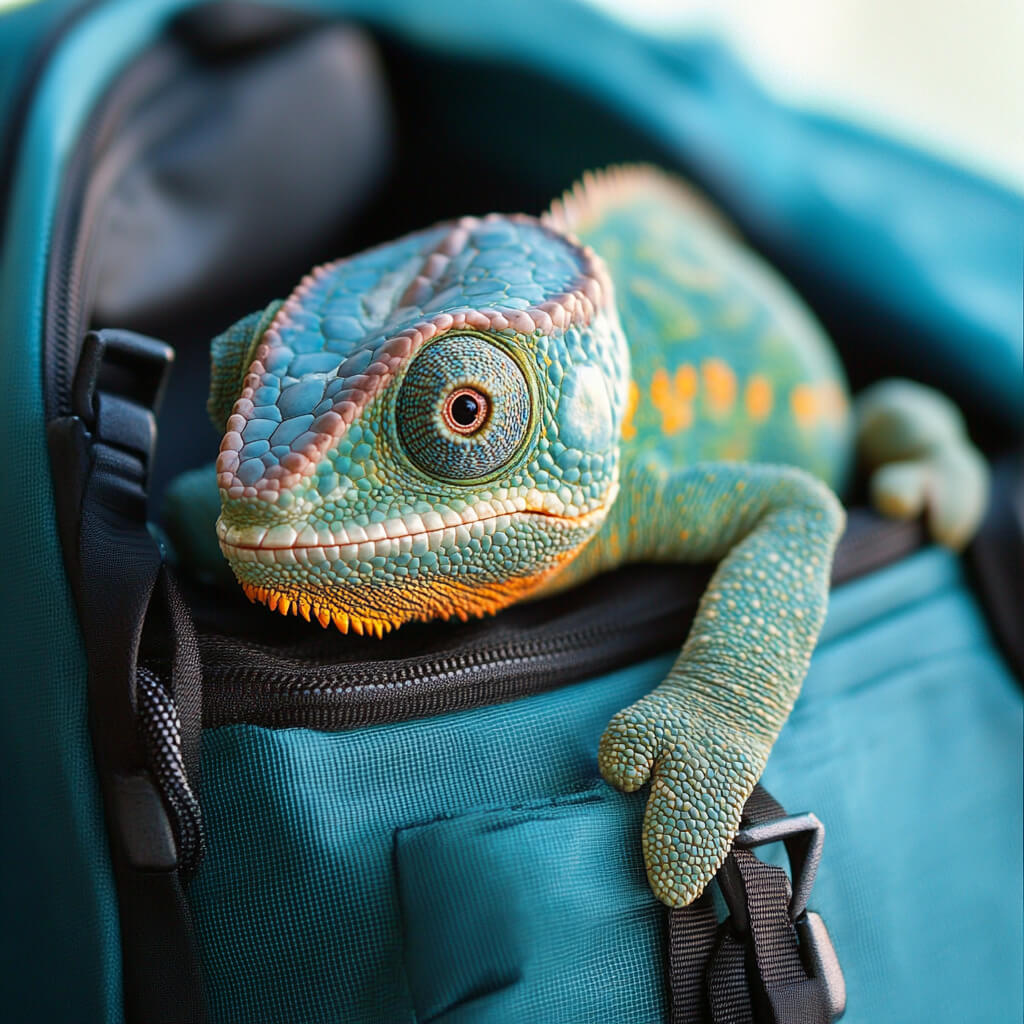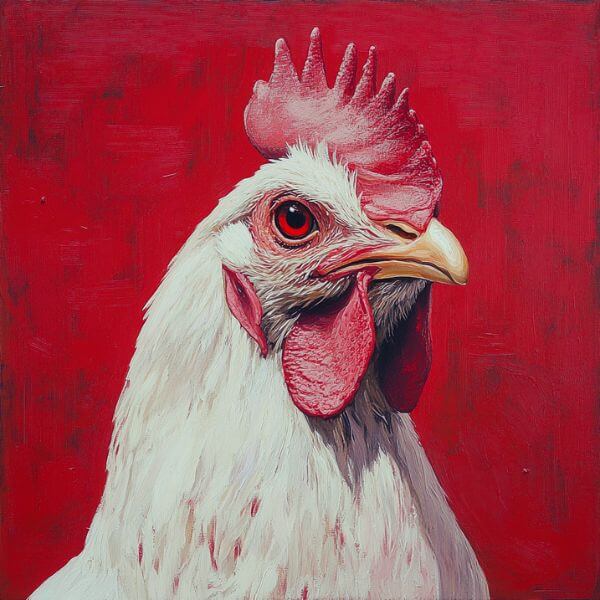Ever thought about bringing a mini dragon into your home?
Well, let me introduce you to the world of veiled chameleons as pets.
These cool creatures are like living rainbows and can make awesome buddies if you know how to care for them.
If you’re looking to get veiled chameleons as pets, continue reading as I uncover the basics and need-to-knows before getting one.
Is a veiled chameleon right for you?
Before you rush out to get a veiled chameleon, let’s chat about whether these funky lizards are a good fit for your life.
Here’s a quick rundown:
| Aspect | What to expect |
| Care level | High – these guys need special attention |
| Time commitment | Daily care and monitoring required |
| Space needed | Large, tall enclosure (at least 2x2x4 feet) |
| Lifespan | 5-8 years (get ready for a long-term friend!) |
| Handling | Limited – they’re more for watching than cuddling |
| Cost | Initial setup can be pricey, plus ongoing care expenses |
If you’re cool with all that, and you’re ready for a pet that’s more of a living art piece than a snuggle buddy, a veiled chameleon might be your perfect match!
Origins of Veiled Chameleon
Alright, let’s get to know these color-changing champs a bit better.
Veiled chameleons, or Chamaeleo calyptratus if you want to get fancy, are like the rock stars of the reptile world.
They’ve got some seriously cool features:
- A funky head crest (like a little crown!)
- Eyes that move independently (talk about multitasking!)
- That famous color-changing skin
- A super long, sticky tongue for nabbing bugs
These guys originally come from Yemen and Saudi Arabia, where they chill in trees and munch on insects.
In the wild, they’re masters of camouflage and can blend in with their leafy homes like ninjas.
Check out other Chameleon Species
Size and lifespan: How big do veiled chameleons get?
Veiled chameleons aren’t tiny, but they’re not exactly Godzilla either.
Here’s what you can expect:
| Gender | Average size | Max size |
| Males | 17-24 inches | Up to 2 feet |
| Females | 10-14 inches | About 18 inches |
As for how long these colorful pals stick around, veiled chameleons typically live for 5-8 years in captivity.
But here’s the cool part – with awesome care, some chameleons have lived up to 12 years!
Want your scaly friend to be a long-term roomie? Here are some tips:
- Serve up a varied, nutritious diet
- Keep their habitat clean and comfy
- Watch for any signs of illness and act fast
- Give them plenty of space to climb and explore
- Keep stress levels low (no chameleon yoga classes, please!)
Setting up a chameleon habitat: The ultimate lizard pad
Now, let’s talk about creating a sweet home for your veiled chameleon. These guys need a special setup to thrive, so let’s break it down:
- The enclosure:
- Go big or go home! At least 2x2x4 feet (taller is better)
- Screen cages are best for good airflow
- No glass tanks – they trap humidity and that’s bad news
- Furnishings:
- Lots of branches and vines for climbing
- Live plants for a natural vibe (and extra humidity)
- A basking spot for soaking up those sweet, sweet UVB rays
- Lighting and heating:
- UVB light (crucial for their health!)
- Basking lamp for warmth
- Keep it toasty: 80-85°F during the day, with a basking spot of 90-95°F
- Nighttime temps can drop to about 70°F
- Humidity:
- Mist the enclosure a few times a day
- Aim for 50-70% humidity (use a hygrometer to check)
- Substrate:
- Paper towels or newspaper work great
- Avoid loose substrates that might be accidentally eaten
How much does is cost to start owning a veiled chameleon?
Setting up a chameleon habitat can cost anywhere from $200 to $500, depending on how fancy you want to get.
But remember, a happy chameleon is worth every penny!
Veiled Chameleons Diet Schedule
Veiled chameleons are like tiny, scaly foodies.
They love their insects, and variety is the spice of life!
Here’s a menu your chameleon would approve:
| Food item | How often | Notes |
| Crickets | Daily staple | Gut-load them for extra nutrition |
| Dubia roaches | 2-3 times a week | Great protein source |
| Mealworms | Occasional treat | High in fat, so go easy |
| Waxworms | Rare treat | Like chameleon candy – use sparingly |
| Hornworms | Once a week | Hydrating and loved by chameleons |
| Leafy greens | Always available | They might nibble, especially when young |
Remember to dust those bugs with calcium powder (with D3) a few times a week.
It’s like a vitamin shake for your chameleon!
Feeding schedule:
- Young chameleons: 10-15 small crickets daily
- Adults: 5-6 large crickets every other day
Pro tip: Don’t leave uneaten insects in the cage. They might nibble on your chameleon while it sleeps – not cool!
Health watch: Keeping your chameleon in tip-top shape
Just like us, chameleons can get sick sometimes. Here are some common health issues to watch out for:
- Metabolic Bone Disease (MBD):
- Caused by lack of calcium or UVB light
- Symptoms: weak bones, tremors, swollen limbs
- Prevention: proper lighting and calcium supplements
- Respiratory infections:
- Often due to poor humidity or temperature
- Symptoms: wheezing, open-mouth breathing, mucus bubbles
- Prevention: maintain proper humidity and temp
- Eye infections:
- Can be caused by vitamin A deficiency or injury
- Symptoms: swollen eyes, discharge
- Prevention: varied diet, clean environment
Finding a reptile vet is super important.
Regular check-ups (once or twice a year) can catch problems early.
Remember, a healthy chameleon is a happy chameleon!
Cuddling with your scaly friend: The gentle approach
Veiled chameleons aren’t exactly cuddle bugs, but with patience, you can handle them gently. Here’s how:
- Start slow – let them get used to your presence
- Approach from below, not above (predators come from above!)
- Let them walk onto your hand – no grabbing!
- Support their whole body when holding them
- Keep handling sessions short (5-10 minutes max)
- Wash your hands before and after handling
Remember, stress is not a chameleon’s friend. If your little buddy seems uncomfortable, give them some space.
Understanding Chameleon Behavior 101
Veiled chameleons have some pretty interesting behaviors. Here’s what to expect:
- Color changes: Not just for camouflage! They change colors based on mood, temperature, and to communicate with other chameleons.
- Head bobbing: This can mean “Hey, I’m here!” or “This is my territory, back off!”
- Hissing: A sign that your chameleon is stressed or feels threatened.
- Basking: They love to soak up the sun (or their basking lamp).
- Tongue flicking: This is how they “smell” their environment.
Veiled chameleons are solitary creatures. They’re happiest living alone, so no chameleon roommates, please!
The Legal Stuff: Do you need a permit to own a veiled chameleon?
Before you bring home a veiled chameleon, make sure it’s legal in your area. Some places have restrictions on exotic pets.
Always get your chameleon from a reputable breeder or rescue.
Wild-caught chameleons are a big no-no!
FAQs
How much does it cost to own a veiled chameleon?
Initial setup can be $300-$500, with monthly costs around $50 for food and supplies.
Can veiled chameleons eat fruit?
They’re mainly insectivores, but may nibble on some fruits. Stick to insects as their main diet.
Do veiled chameleons need a water dish?
Nope! They prefer to drink water droplets from leaves. That’s why misting is so important.
How often should I clean the chameleon’s enclosure?
Spot clean daily, and do a deep clean every 2-4 weeks.
Wrapping it up: Your chameleon adventure awaits!
Alright, future chameleon champs, we’ve covered a lot of ground!
Owning a veiled chameleon can be an amazing experience if you’re ready for the commitment.
These colorful creatures need special care, but they’ll reward you with their fascinating behavior and stunning looks.
Remember, a happy chameleon is all about the right habitat, diet, and care.
So, if you’re ready to embark on this scaly adventure, go forth and create an awesome home for your new veiled chameleon pet!







Leave a Reply